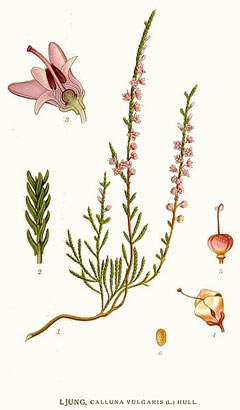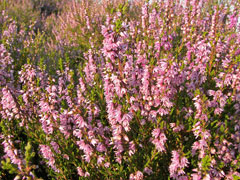 |
|
http://commons.wikimedia.org/wiki/File:147_Calluna_vulgaris.jpg |
 |
| http://commons.wikimedia.org/wiki/File:Calluna_vulgaris_001.jpg |
Translate this page:
Summary
Bloom Color: Pink, Purple, Red.
Main Bloom Time: Early fall, Late summer, Mid summer. Form: Rounded, Spreading or horizontal, Upright or erect.
Physical Characteristics

 Calluna vulgaris is an evergreen Shrub growing to 0.6 m (2ft) by 0.5 m (1ft 8in).
Calluna vulgaris is an evergreen Shrub growing to 0.6 m (2ft) by 0.5 m (1ft 8in).
See above for USDA hardiness. It is hardy to UK zone 4. It is in leaf all year, in flower from July to October, and the seeds ripen from October to November. The species is hermaphrodite (has both male and female organs) and is pollinated by Bees, flies, Lepidoptera (Moths & Butterflies), wind.
It is noted for attracting wildlife.
Suitable for: light (sandy) and medium (loamy) soils and can grow in nutritionally poor soil. Suitable pH: mildly acid soils and can grow in very acid soils.
It can grow in semi-shade (light woodland) or no shade. It prefers dry or moist soil. The plant can tolerate maritime exposure.
UK Hardiness Map
US Hardiness Map
Synonyms
Erica vulgaris.
Plant Habitats
Woodland Garden Dappled Shade; Shady Edge; Ground Cover; Hedge;
Edible Uses
Edible Parts: Shoots
Edible Uses: Condiment Tea
A tea is made from the flowering stems[177, 183]. A kind of mead was once brewed from the flowers and the young shoots have been used instead of hops to flavour beer[7, 183].
References More on Edible Uses
Medicinal Uses
Plants For A Future can not take any responsibility for any adverse effects from the use of plants. Always seek advice from a professional before using a plant medicinally.
Antianxiety Antirheumatic Antiseptic Bach Cholagogue Depurative Diaphoretic Diuretic
Expectorant Sedative Urinary Vasoconstrictor
Heather has a long history of medicinal use in folk medicine. In particular it is a good urinary antiseptic and diuretic, disinfecting the urinary tract and mildly increasing urine production[254]. The flowering shoots are antiseptic, astringent, cholagogue, depurative, diaphoretic, diuretic, expectorant, mildly sedative and vasoconstrictor[7, 8, 9, 21, 165, 238]. The plant is often macerated and made into a liniment for treating rheumatism and arthritis, whilst a hot poultice is a traditional remedy for chilblains[7, 254]. An infusion of the flowering shoots is used in the treatment of coughs, colds, bladder and kidney disorders, cystitis etc[9, 238, 254]. A cleansing and detoxifying plant, it has been used in the treatment of rheumatism, arthritis and gout[254]. The flowering stems are harvested in the autumn and dried for later use[7]. The plant is used in Bach flower remedies - the keywords for prescribing it are 'Self-centredness' and 'Self-concern'[209]. A homeopathic remedy is made from the fresh branches[9]. It is used in the treatment of rheumatism, arthritis and insomnia[9].
References More on Medicinal Uses
The Bookshop: Edible Plant Books
Our Latest books on Perennial Plants For Food Forests and Permaculture Gardens in paperback or digital formats.

Edible Tropical Plants
Food Forest Plants for Hotter Conditions: 250+ Plants For Tropical Food Forests & Permaculture Gardens.
More

Edible Temperate Plants
Plants for Your Food Forest: 500 Plants for Temperate Food Forests & Permaculture Gardens.
More

More Books
PFAF have eight books available in paperback and digital formats. Browse the shop for more information.
Shop Now
Other Uses
Basketry Besom Dye Fuel Hedge Hedge Insulation Musical Tannin Thatching
The branches have many uses, including in thatching, as a bedding or a stuffing for mattresses, for insulation, basketry, rope making and for making brooms[6, 7, 11, 46, 61, 66, 100, 254]. The dried branches are a good fuel[6, 66]. The rootstock can be made into musical pipes[254]. A yellow dye is obtained from the plant[7, 46, 61]. The bark is a source of tannin[46]. Heather can be grown as a low hedge and is quite useful as an edging to beds. It is fairly amenable to trimming[29]. A useful ground cover plant for covering dry banks[188, 197]. The cultivar 'White Lawn' has been recommended[188]. All except the very dwarf cultivars will need trimming each spring in order to keep them compact[208].
Special Uses
Attracts Wildlife Food Forest Ground cover Hedge Hedge
References More on Other Uses
Cultivation details
Landscape Uses:Alpine garden, Border, Foundation, Ground cover, Massing, Rock garden, Specimen. Requires a light acid soil and a sunny position[138, 182]. Prefers a sunny position but tolerates light shade[186]. Only succeeds if the pH is below 6.5[186]. Prefers a poor peaty soil[11]. Plants are tolerant of fairly dry soils but they dislike prolonged drought[186]. They tolerate wet conditions in the winter[238]. Plants regenerate well from the base after a fire if the heat was not too great, if the fire was slow and intense then new seedlings will quickly become established[186]. Commonly grown in the ornamental garden, there are many named varieties[200, 238]. The flowers are rich in nectar and are very attractive to bees, butterflies and moths[7, 11, 30]. This plant is also an important food source for the caterpillars of many lepidoptera[30]. Special Features:Attractive foliage, Not North American native, Suitable for cut flowers, Suitable for dried flowers, Attractive flowers or blooms. In garden design, as well as the above-ground architecture of a plant, root structure considerations help in choosing plants that work together for their optimal soil requirements including nutrients and water. The root pattern is branching: a heart root, dividing from the crown into several primary roots going down and out [2-1].
References Carbon Farming Information and Carbon Sequestration Information
Temperature Converter
Type a value in the Celsius field to convert the value to Fahrenheit:
Fahrenheit:
The PFAF Bookshop
Plants For A Future have a number of books available in paperback and digital form. Book titles include Edible Plants, Edible Perennials, Edible Trees,Edible Shrubs, Woodland Gardening, and Temperate Food Forest Plants. Our new book is Food Forest Plants For Hotter Conditions (Tropical and Sub-Tropical).
Shop Now
Plant Propagation
Seed - sow as soon as it is ripe or in February in a shaded part of the greenhouse[78, 113]. Surface sow or only just cover the seed[113, 138]. Cold stratification for 4 - 20 weeks aids germination[138]. The seed usually germinates in 1 - 2 months at 20°c. When large enough to handle, prick the seedlings out into individual pots and grow them on in the greenhouse for at least their first winter, planting them out into their permanent positions in late spring or early summer, after the last expected frosts. Cuttings of half-ripe wood 4 - 5cm with a heel, July/August in a frame. Good percentage[78]. Cuttings of mature wood of the current season's growth, 5 - 7cm with a heel, October/November in a frame. Good percentage[78]. Layering in autumn[78]. Division in spring. Dig up the plant 12 months prior to division and replant it 15 - 30cm deeper in the soil in order to encourage rooting along the stems. When ready to take the divisions, it is just a matter of digging up the plant and cutting off sections of stem with roots on them. These are best potted up and kept in a cold frame or greenhouse until they are well rooted before planting them out in the summer or following spring.
Other Names
If available other names are mentioned here
Native Range
TEMPERATE ASIA: Turkey, Russian Federation-Western Siberia (Western Siberia), Russian Federation-Eastern Siberia (Eastern Siberia), Russian Federation (Altay) EUROPE: Denmark, United Kingdom, Ireland, Norway, Sweden, Austria, Belgium, Switzerland, Germany, Hungary, Netherlands, Poland, Russian Federation (European part), Belarus, Lithuania, Latvia, Ukraine, Albania, Bulgaria, Greece, Croatia, Italy, Romania, Serbia, Slovenia, Spain, France, Portugal AFRICA: Portugal (Azores, Madeira Islands), Morocco
Weed Potential
Right plant wrong place. We are currently updating this section.
Please note that a plant may be invasive in one area but may not in your area so it's worth checking.
Conservation Status
IUCN Red List of Threatened Plants Status :

Growth: S = slow M = medium F = fast. Soil: L = light (sandy) M = medium H = heavy (clay). pH: A = acid N = neutral B = basic (alkaline). Shade: F = full shade S = semi-shade N = no shade. Moisture: D = dry M = Moist We = wet Wa = water.
Now available:
Food Forest Plants for Mediterranean Conditions
350+ Perennial Plants For Mediterranean and Drier Food Forests and Permaculture Gardens.
[Paperback and eBook]
This is the third in Plants For A Future's series of plant guides for food forests tailored to
specific climate zones. Following volumes on temperate and tropical ecosystems, this book focuses
on species suited to Mediterranean conditions—regions with hot, dry summers and cool, wet winters,
often facing the added challenge of climate change.
Read More
Expert comment
Author
(L.)Hull.
Botanical References
1117200
Links / References
For a list of references used on this page please go here
Readers comment
| Add a comment |
|
If you have important information about this plant that may help other users please add a comment or link below. Only comments or links that are felt to be directly relevant to a plant will be included. If you think a comment/link or information contained on this page is inaccurate or misleading we would welcome your feedback at [email protected]. If you have questions about a plant please use the Forum on this website as we do not have the resources to answer questions ourselves.
* Please note: the comments by website users are not necessarily those held by PFAF and may give misleading or inaccurate information.
To leave a comment please Register or login here All comments need to be approved so will not appear immediately.
|
Subject : Calluna vulgaris
|
|
|
|